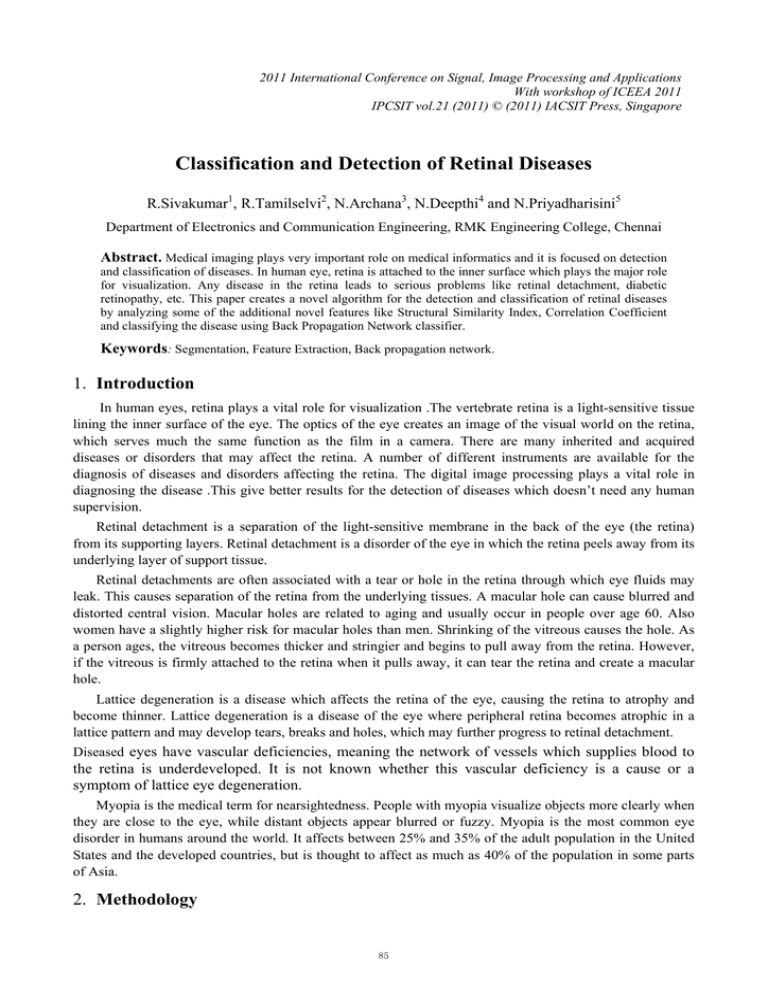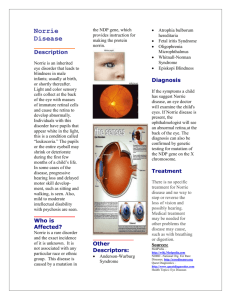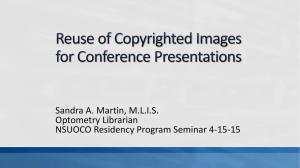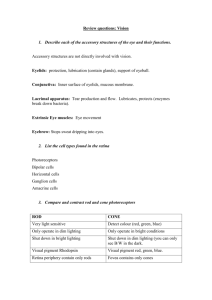Document 13134635
advertisement

2011 International Conference on Signal, Image Processing and Applications With workshop of ICEEA 2011 IPCSIT vol.21 (2011) © (2011) IACSIT Press, Singapore Classification and Detection of Retinal Diseases R.Sivakumar1, R.Tamilselvi2, N.Archana3, N.Deepthi4 and N.Priyadharisini5 Department of Electronics and Communication Engineering, RMK Engineering College, Chennai Abstract. Medical imaging plays very important role on medical informatics and it is focused on detection and classification of diseases. In human eye, retina is attached to the inner surface which plays the major role for visualization. Any disease in the retina leads to serious problems like retinal detachment, diabetic retinopathy, etc. This paper creates a novel algorithm for the detection and classification of retinal diseases by analyzing some of the additional novel features like Structural Similarity Index, Correlation Coefficient and classifying the disease using Back Propagation Network classifier. Keywords: Segmentation, Feature Extraction, Back propagation network. 1. Introduction In human eyes, retina plays a vital role for visualization .The vertebrate retina is a light-sensitive tissue lining the inner surface of the eye. The optics of the eye creates an image of the visual world on the retina, which serves much the same function as the film in a camera. There are many inherited and acquired diseases or disorders that may affect the retina. A number of different instruments are available for the diagnosis of diseases and disorders affecting the retina. The digital image processing plays a vital role in diagnosing the disease .This give better results for the detection of diseases which doesn’t need any human supervision. Retinal detachment is a separation of the light-sensitive membrane in the back of the eye (the retina) from its supporting layers. Retinal detachment is a disorder of the eye in which the retina peels away from its underlying layer of support tissue. Retinal detachments are often associated with a tear or hole in the retina through which eye fluids may leak. This causes separation of the retina from the underlying tissues. A macular hole can cause blurred and distorted central vision. Macular holes are related to aging and usually occur in people over age 60. Also women have a slightly higher risk for macular holes than men. Shrinking of the vitreous causes the hole. As a person ages, the vitreous becomes thicker and stringier and begins to pull away from the retina. However, if the vitreous is firmly attached to the retina when it pulls away, it can tear the retina and create a macular hole. Lattice degeneration is a disease which affects the retina of the eye, causing the retina to atrophy and become thinner. Lattice degeneration is a disease of the eye where peripheral retina becomes atrophic in a lattice pattern and may develop tears, breaks and holes, which may further progress to retinal detachment. Diseased eyes have vascular deficiencies, meaning the network of vessels which supplies blood to the retina is underdeveloped. It is not known whether this vascular deficiency is a cause or a symptom of lattice eye degeneration. Myopia is the medical term for nearsightedness. People with myopia visualize objects more clearly when they are close to the eye, while distant objects appear blurred or fuzzy. Myopia is the most common eye disorder in humans around the world. It affects between 25% and 35% of the adult population in the United States and the developed countries, but is thought to affect as much as 40% of the population in some parts of Asia. 2. Methodology 85 Fig.1: Proposed System 3. Segmentation In computer vision, segmentation refers to the process of partitioning a digital image into multiple segments (sets of pixels, also known as super pixels). The goal of segmentation is to simplify and/or change the representation of an image into something that is more meaningful and easier to analyze. Some of the segmentation techniques are masking, thresholding, edge detection, compression-based methods, histogram methods, region growing methods, and split and merge methods and boundary extraction. 4. Feature Extraction The aim of texture analysis is texture recognition and texture based shape analysis. The texture can be studied in two levels namely statistical and structural. On the statistical level, the texture of an image is defined by a set of statistics extracted from the entire texture region. On the structural level, a texture is defined by sub patterns called primitives. The various statistical methods are based on capturing the variability in grey scale images. The textural character of an image depends on the spatial size of texture primitives. 5. Classification 5.1 Neural network classifiers The semi-linear feed forward neural network is an effective system for learning discriminant patterns for a number of different applications. The BP learning method is an iterative process used to train the feed forward neural network for minimal response error. An input pattern is applied to the network and forward propagated through the network using the initial node connection weights. Output error is determined then back propagated to establish a new set of network connection weights. The process is continued until a prescribed minimum error is achieved. 86 Fig. 2: BPN Classifier 6. Results 6.1 Results of retinal detachment 6.2 Results of macular hole 87 6.3 Results of lattice regeneration 6.4. Results of Myopia 88 7. Results And Discussions The proposed work deals about the retinal diseases and the feature extraction based on the various parameters. The abnormalities of the various diseases are detected using the segmentation algorithm and the compared with the normal images. The feature extraction shows the corresponding variations among the diseases based on the required parameters. The neural networks trained with the required input classify the diseases. The proposed work gives the efficiency of 99%. 8. Conclusion The automatic detection of the retinal disease is done by three stages. They are segmentation, feature extraction and classification.In segmentation, edge detection technique is used which gives a clear outlined border in the retinal image where the infected part has been segmented and highlighted. The various features have been extracted from the segmented region. The basic features that have been extracted are mean, mode, entropy, RMS value, variance and standard deviation. The correlation coefficient and similarity index features that have been used will give us a perfect variation level between various diseases. When compared to the features such as correlation distance, Zernike space moments and luminance that are used in previous research works. These features extracted are used for classifying the diseases depending upon the feature ranges.Computer based diagnosis of retinal diseases is one of the most important tasks when dealing with a diseased images. Our project gives a efficient method of the classical and up to date methods for classifying and diagnosing the type of retinal disease and detecting its features after diagnosis of the disease using mat lab. Automatic diagnosis of retinal diseases at an earlier stage still remains an open problem. Our project uses efficient algorithms for the detection of the diseased region and features such as correlation coefficient and similarity index and gives better results for classification. 9. References [1] D.Jayanthi - PG Scholar, N.Devi - Senior Lecturer, S.SwarnaParvathi -Senior Lecturer, Sri Venkateshwara College - “Automatic diagnosis of retinal diseases from color retinal diseases.” - International Journal of Computer Science and Information Security, IJCSIS, Vol. 7, No. 1, pp. 234-238, January 2010, USA. [2] Diego Marín, Arturo Aquino, Manuel Emilio Gegúndez-Arias, and José Manuel Bravo –“A New Supervised Method for Blood Vessel .Segmentation in Retinal Images by Using Gray – Level and Moment Invariants-Based Features”- Vol. 23, no. 10, pp. 1189–1195, Oct. 2004. [3] Manish Sarkar, B. Yegnanarayana, Deepak Khemani - Neural Networks Laboratory, Department of Computer Science and Engineering, Indian Institute of Technology, Madras 600 036, India - “Back propagation learning algorithms for classification with fuzzy Mean square error.” Vol.19, pp.43–51,1998. [4] Mr. Salem Saleh Al-amri, Dr. N.V. Kalyankar and Dr. Khamitkar S.D –“Image Segmentation By Using Edge Detection”- (IJCSE) International Journal on Computer Science and Engineering,Vol. 02, No. 03, pp. 804807,2010. [5] B. Soares, Jorge J. G. Leandro, Roberto M. Cesar-Jr., Herbert F. Jelinek, and Michael J. Cree - “Retinal Vessel Segmentation Using the 2-D Morlet Wavelet and Supervised Classification.” Vol. 12, no. 2, pp. 334–341,2006 89







